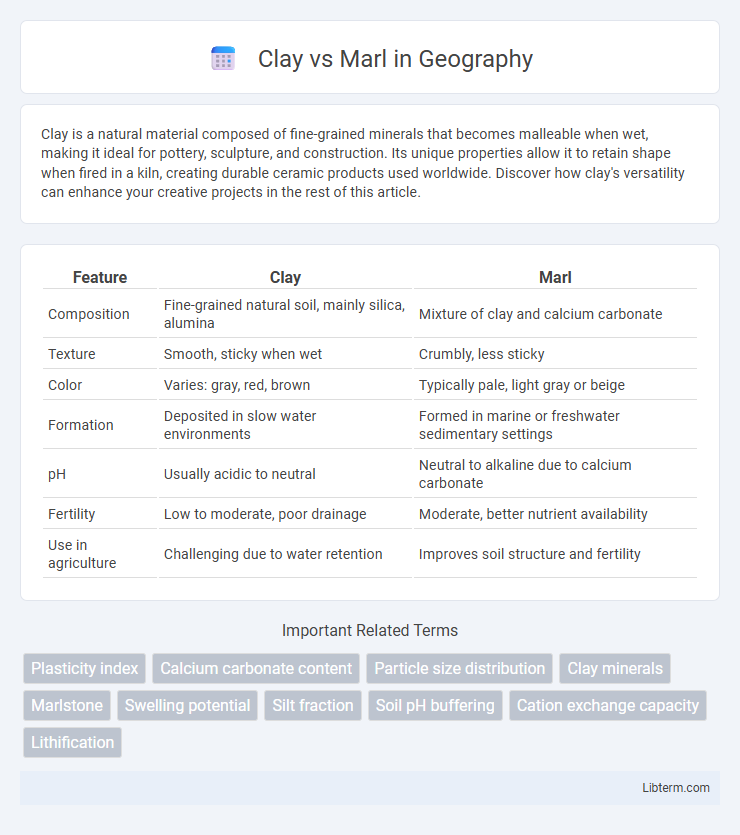Clay is a natural material composed of fine-grained minerals that becomes malleable when wet, making it ideal for pottery, sculpture, and construction. Its unique properties allow it to retain shape when fired in a kiln, creating durable ceramic products used worldwide. Discover how clay's versatility can enhance your creative projects in the rest of this article.
Table of Comparison
| Feature | Clay | Marl |
|---|---|---|
| Composition | Fine-grained natural soil, mainly silica, alumina | Mixture of clay and calcium carbonate |
| Texture | Smooth, sticky when wet | Crumbly, less sticky |
| Color | Varies: gray, red, brown | Typically pale, light gray or beige |
| Formation | Deposited in slow water environments | Formed in marine or freshwater sedimentary settings |
| pH | Usually acidic to neutral | Neutral to alkaline due to calcium carbonate |
| Fertility | Low to moderate, poor drainage | Moderate, better nutrient availability |
| Use in agriculture | Challenging due to water retention | Improves soil structure and fertility |
Introduction to Clay and Marl
Clay is a fine-grained natural soil material composed primarily of hydrous aluminum phyllosilicates with particle sizes less than 0.002 mm, known for its plasticity when wet and high compressive strength when dry. Marl is a sedimentary rock consisting of a mixture of clay and calcium carbonate, typically formed in marine or freshwater environments and exhibiting properties intermediate between limestone and clay. Understanding the composition and formation of clay and marl is crucial in fields such as geology, agriculture, and construction due to their differing physical and chemical characteristics.
Geological Formation of Clay vs Marl
Clay forms primarily through the chemical weathering and mechanical breakdown of silicate minerals, resulting in fine-grained particles dominated by hydrous aluminosilicates like kaolinite, illite, and montmorillonite, often accumulating in low-energy depositional environments such as lake beds and deep marine settings. Marl consists of a mixture of clay minerals and calcium carbonate, typically forming in marine or lacustrine environments where biological activity contributes to carbonate accumulation, resulting in a sedimentary rock with variable proportions of clay and calcite. Geological formations of clay frequently display homogeneity and plasticity due to the dominance of clay minerals, whereas marl exhibits textural and compositional heterogeneity influenced by biogenic carbonate inputs and sedimentation rates.
Key Physical Properties Compared
Clay exhibits fine particles with high plasticity and low permeability, making it cohesive and capable of retaining water, whereas marl contains a mixture of clay and calcium carbonate, resulting in a firmer texture with moderate plasticity and better drainage. The plasticity index of clay typically ranges from 20 to 40, whereas marl's plasticity index is often lower due to the calcareous content, influencing its behavior under compression and shear stress. Clay's higher shrink-swell potential contrasts with marl's stability, making marl more suitable for construction requiring less dimensional change.
Chemical Composition Differences
Clay primarily consists of hydrous aluminum silicates such as kaolinite, illite, and montmorillonite, characterized by a higher silica (SiO2) and alumina (Al2O3) content. Marl contains a significant amount of calcium carbonate (CaCO3), often exceeding 35%, mixed with varying percentages of clay minerals, which distinguishes its chemical composition from pure clays. The presence of carbonate minerals in marl reduces the overall silica and alumina concentration compared to typical clay deposits.
Uses in Construction and Industry
Clay is widely used in construction for making bricks, tiles, and cement due to its plasticity and fire resistance. Marl, a lime-rich mudstone, is primarily utilized in agriculture to improve soil pH and in construction as a raw material in cement manufacturing. Both materials contribute to the durability and strength of building structures, with clay offering excellent moldability and marl enhancing mortar quality through its calcium carbonate content.
Impact on Soil Fertility and Agriculture
Clay soils, rich in fine mineral particles, retain nutrients and water effectively, supporting robust plant growth but often requiring careful management to prevent poor drainage and compaction. Marl, a calcium carbonate-rich soil amendment, improves soil pH and enhances nutrient availability, particularly in acidic soils, promoting better crop yields and overall soil fertility. The choice between clay and marl influences agricultural practices, with clay favoring moisture retention and marl optimizing soil chemistry for nutrient uptake.
Environmental Considerations
Clay soils exhibit low permeability, reducing the risk of groundwater contamination but may cause poor drainage and increased runoff leading to surface water pollution. Marl, composed of calcium carbonate-rich clay and silt, offers better drainage and neutralizes acidic soils, positively impacting agricultural sustainability and reducing soil erosion. Both materials require careful management to minimize environmental impacts, particularly in construction and land use planning.
Economic Value and Market Demand
Clay offers higher economic value in pottery and construction due to its plasticity and strength, driving significant market demand in ceramics and brick manufacturing industries. Marl, rich in calcium carbonate, is essential for agriculture as a soil conditioner, creating steady demand in farming sectors aiming to improve soil pH and fertility. Market trends show clay's versatility fuels growth in urban infrastructure projects, while marl's niche agricultural applications sustain consistent economic value in rural markets.
Testing and Identification Methods
Testing and identification methods for clay and marl primarily involve particle size analysis, chemical composition, and plasticity tests. Clay is characterized by particles smaller than 0.002 mm and high plasticity index, while marl contains a mixture of clay and calcium carbonate, identified through acid tests that produce effervescent reactions with marl but not with pure clay. X-ray diffraction and Atterberg limits tests further differentiate clay's mineralogical properties from marl's calcareous content.
Conclusion: Choosing Between Clay and Marl
Clay offers excellent water retention and nutrient-holding capacity, making it ideal for crops requiring consistent moisture. Marl, with its higher calcium carbonate content, improves soil alkalinity and structure, benefiting plants sensitive to acidic conditions. Selecting between clay and marl depends on specific crop needs, soil pH preferences, and drainage requirements to optimize agricultural productivity.
Clay Infographic

 libterm.com
libterm.com